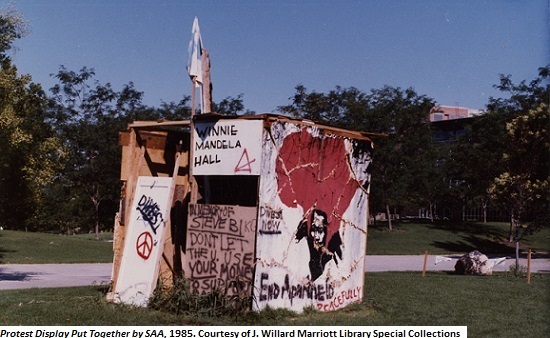Dublin Core
Title
Description
In the mid-nineteen eighties, global pressure was mounting against the apartheid regime in South Africa. Learn how persistent student activists at the University of Utah forced their campus to confront its connections to an oppressive regime half a world away.
At the outset of the 1980s, the University of Utah held $2.1 million dollars of stock in companies that did business in South Africa. Such tacit support for the racist apartheid regime did not sit well with students concerned with social justice. Spurred by violence against black South Africans in 1985, a group of activists at the University of Utah joined thousands of students across the country to lobby their universities to divest from South Africa.
The activists faced an uphill battle. The University argued that investments had no connection to politics, and motivating students preoccupied with schoolwork was difficult. But the activists began to build a grassroots movement by educating their fellow students about apartheid and divestment. One of their most effective tactics was building shanties in the center of campus as a place to hold teach-ins. The shanties were occupied in ongoing protest and were a reminder of the living conditions of non-white South Africans. In 1986, the shanties were firebombed twice in as many weeks by counter-demonstrators. When University administrators threatened to remove the shanties, the activists sued on grounds of free speech – and won. Working for free and at risk to their degrees, the activists were driven by moral and ethical concerns. One student nicknamed “Mother Mormon for Divestment” spoke up often to show that the cause was “not only for liberals and radicals.” The movement forced political discussions “about race, rights, and duties [that] might not otherwise [take] place” on campus and in the community.
The movement’s culmination came in May 1987 at a meeting of the Council that controlled the University’s investments. In a carefully coordinated demonstration, eight activists disrupted the meeting to read a statement about divestment over calls for order. As each reader was arrested and removed, another stepped up. The protest was well-covered by local media, and the resulting public uproar was the final straw. Within a month, the University decided to divest.
Reflecting on his work to build campus support for divestment, one student recalled how “People’s lives were dramatically transformed. The experience of coordinating and leading an organized activist movement was powerful… [and satisfying to see] an important task fulfilled.”
Creator
Source
Image: University of Utah students built shanties named Winnie Mandela Hall and Bishop Desmond Tutu Hall after South African liberation leaders to bring attention to the role of US financial support of segregated South Africa. Using the words of Coretta Scott King, the builders claimed that “injustice anywhere is a threat to justice everywhere; we have erected this shanty to protest apartheid.” Courtesy of J. Willard Marriott Library, Special Collections.
_______________
See Benjamin Harris, “’In Deed and Word’: The Anti-Apartheid Movement at the University of Utah 1978-1987,” Utah Historical Quarterly, volume75, number 3, pp. 258-276.

